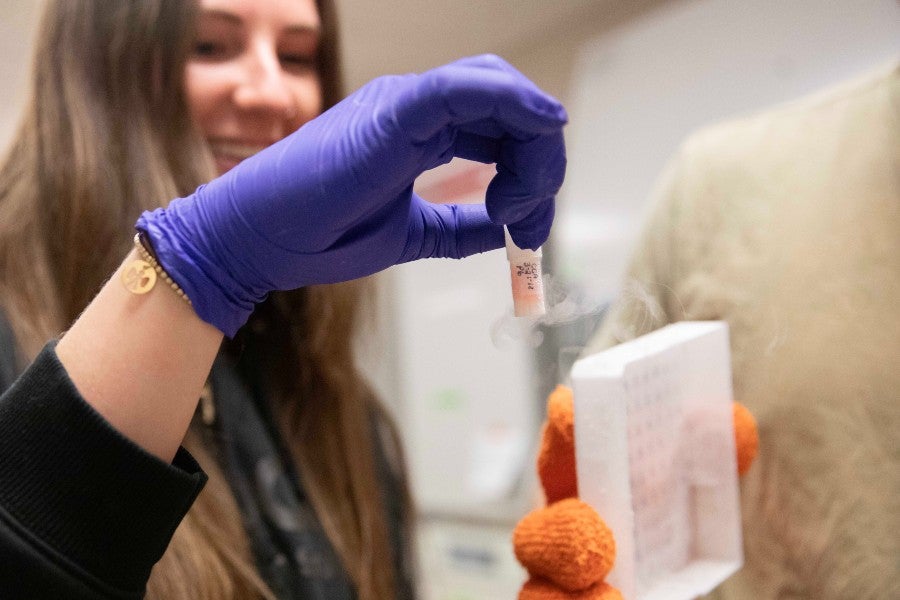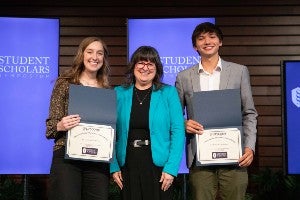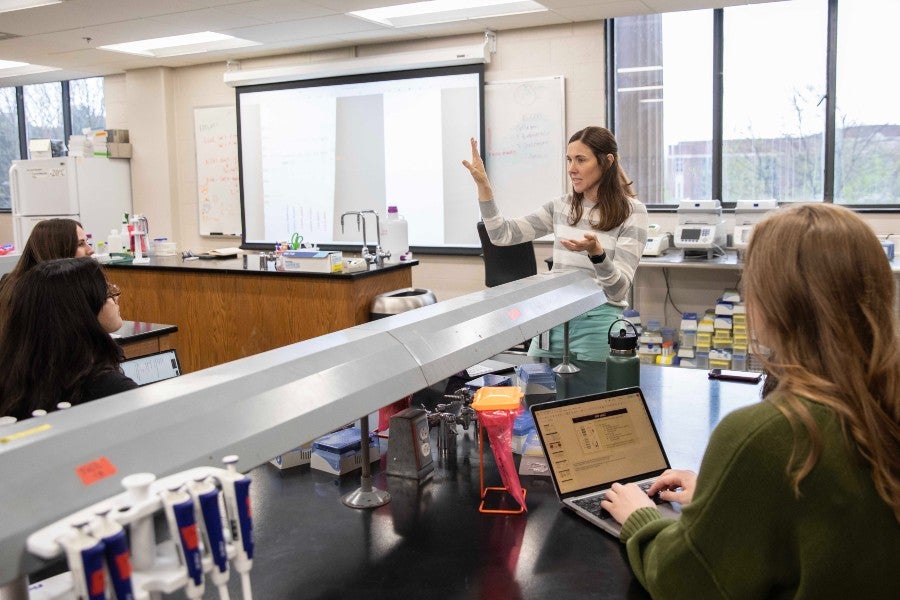Discovery in science. Discovery of self.
Biology department’s three-tier system of student involvement brings the benefits of conducting research to students earlier and more meaningfully in their college career.
By Janel Shoun-Smith | 615-966-7078 |

There is perhaps no other field that draws more students interested in conducting research than biology. Yet at most institutions, undergraduate biology majors get little exposure to conducting research hands-on, delaying that valuable experience until graduate or professional school programs.
Lipscomb’s biology professors decided that was too late.
Four years ago, they enacted a new three-tier system designed to get more undergraduates into the lab conducting hands-on experiments earlier and thinking deeper about how to solve thorny questions. This past spring, more than 70 biology students were involved in conducting, assisting or learning how to conduct lab research in one way or another, outside of required lab courses.
The benefits of involvement in research—critical and creative thinking, written and oral communication, teamwork, complex problem solving and mentor relationships with faculty, among many others—are just too important to put off.
Biology faculty have long worked to provide hands-on research experiences for undergraduate students in McFarland’s labs, but even just a few years ago those opportunities were still somewhat exclusive and not as comprehensive as they could be.
In 2020, then department-chair Beth Conway (LA ’98) was searching for ways to get undergraduate students involved in hands-on research earlier, not only to benefit them in their future endeavors, but to also benefit the research projects of the department.
“I realized I was spending a lot of time training juniors and seniors in the lab, only to lose their skills in two years’ time when they graduated. They didn’t really have time to fully engage those newly learned skills in their own research,” said Conway, now professor of biology and associate chair of the department.
“It’s better for the students to start earlier,” said Brian Ellis, associate professor of biology, who came up with an idea that the department adopted. “We value what research can teach students, but it also helps the students compete if they plan to go to medical school. Those schools know that many students are just checking the research box when they begin in their junior or senior year.”

Conway threw the challenge out to the biology faculty to figure out a way to open the lab doors to more undergraduate students, and the three-tiered system of incentives that Ellis devised has had impressive results.
- Tier One: As early as their freshman year, biology students are invited to come at specified lab times to learn basic lab skills as an extracurricular activity. These students learn from the professor and shadow upperclassmen as they carry out experiments.
- Tier Two: Once they have demonstrated their lab skills and can produce repeatable data, students move on to learn more advanced skills, either as an extracurricular activity or they have the option of enrolling for one or two hours of research credit for the work they do in the lab.
- Tier Three: Finally, those students who are particularly adept and skilled at the research techniques have the opportunity to not only conduct experiments on their own, but to also teach and demonstrate skills to the tier-one and -two students. They have the option of enrolling for three hours of research credit, which counts as an elective, and become eligible to receive a stipend to conduct additional research during the summer.

Brian Ellis
“We all have research projects that are novel and we believe can move the field, so the goal for all of us is to have research that is repeatable,” Ellis said of the biology faculty. “You can’t really accomplish that goal if you get all your training as a junior and only have your senior year to actually conduct the experiments.”
Each biology professor has the freedom to refine the tier-system to the benefit of their particular students and particular research investigation, said Ellis.
Ellis has about 10 students, up from two previously, working in his lab each year on a project to test drugs that kill parasitic worms such as hookworm and ringworm, ailments that impact 1.5 billion people around the globe.
He requires his students to work in the lab six hours a week and all of them except freshman must present in the annual Student Scholars Symposium. The stipend for a summer research spot is the most popular incentive among his students, Ellis said.

“The system provides a structure for faculty to more formally categorize how well students are doing,” said Ellis. “For students, it helps students to just try it out at first and to figure out their goals early. Most come into biology with the default goal of medical school, but involvement in research shows them that there are so many other avenues in the field.”
Students whose work excels may have the opportunity to present their work at the national conferences regularly attended by faculty, including the Association of Southeast Biologists and the American Scientific Affiliation, said Ellis.
For Conway, the number of students involved in her research has jumped from about four per year to around 25 this school year, with five students serving as tier-three lab leaders, she said.
Conway and her students are specifically studying triple negative breast cancers, the most aggressive breast cancer subtype with the worst prognosis and the fewest therapeutic options.

“I started saying yes to every student,” said Conway. “The first year I spent a lot of time training the group outside of class time, working on the basic techniques. There were about 15 students at that time. A few of them rose to the top very quickly and they began asking for research experiments of their own.”
The lab leaders have ownership over their own projects, said Conway. They plan the experiments and have weekly meetings with Conway throughout the process to discuss the experiment design, the data collected and questions to fuel the next experiment. The student leaders communicate with their student team themselves on the details of carrying out the experiment, and lower-tier students help make it happen.
Conway’s lab leaders are spending 10 to 15 hours in the lab per week, voluntarily, and all their experiments relate to her overall research goal, she said. The system has definitely increased the productivity, efficiency and speed of her lab research experiments, she said.
“It takes more of the professor’s time outside of class, but the payoff has been really beneficial to the pace of our research and has given many more students exposure to research,” Conway said.
Exposure that students would not get at a high-activity research university until much later in their college careers.

Ellie Griner (right) works as a student team leader and mentor in Lipscomb faculty Beth Conway's biology lab. Here she helps honors student Beaman Adel learn about the lab equipment.
“I have a lot more independence, and I am able to design and run experiments that I am interested in,” said Ellie Griner, a rising senior from Valdosta, Georgia, and one of Conway’s tier-three lab leaders.
“The research we are doing is very complex and there are always multiple routes you can take. We can take one set of data in so many directions. Dr. Conway will sit down with us and talk about her ideas and our ideas. She does a very good job of listening to our ideas and allowing us to act on those.”
Lipscomb’s focus on providing that early exposure to research was “a huge factor in deciding to come here” said Kai Lam, a rising junior from Chattanooga, Tennessee who serves as one of Conway’s lab leaders.
“The fact that freshmen can come in and do research was a big thing, and that the faculty are one-on-one and will be engaging with me for all four years. I need those relationships,” he said.

Lam began the lab tier process as a second-semester freshman. It took a lot of overcoming fear, practice and trial and error to reach the tier-three status, but it was worth it for the experience he gained, he said.
“We do a ton of research outside the lab, so that we can engage in discourse with Dr. Conway,” he said. “Most of the time the experiments don’t go exactly as you plan, so you have to be very efficient and you have to adapt… The biggest thing to learn is time management and learning to delegate and trust others. That has been a real growth area for me through my research time.”
Conway’s tier-three students are also encouraged to present at Lipscomb's Student Scholars Symposium and external conferences, including an annual Meharry-Vanderbilt Alliance conference in Nashville.
“This has definitely shown me that I do want to do research in the future,” said Lam. “I don’t always love being in the lab—you are often in there late and it’s taking away from time with friends, but the result and impact of what you are doing outweighs all of that.”